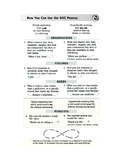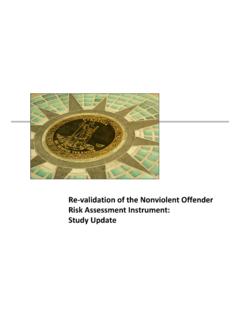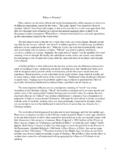Transcription of 11-NCI-WEB-017.ppt - Crisis Prevention Institute (CPI)
1 6/13/2011. CPI's eRefresher Series for nonviolent Crisis Intervention Certified Instructors Unit VIII: nonviolent Physical Crisis InterventionSM. and Team Intervention 2011. AGC2. eRefresher Series Welcome to CPI's eRefresher Series for nonviolent Crisis Intervention Certified . Instructors Moderator: Susan Keith Program Developer and Professional Staff Instructor 2011 2. eRefresher Series Pre-Test (aired October 6, 2010). Unit I: The CPI Crisis Development ModelSM. (aired November 10, 2010). Unit II: Nonverbal Behavior (aired December 15, 2010).
2 Unit III: Paraverbal Communication (aired January 12, 2011). Unit IV: Verbal Intervention (aired February 9, 2011). Unit V: Precipitating Factors, Rational Detachment, Integrated Experience (aired March 9, 2011). 2011 3. 1. 6/13/2011. eRefresher Series Unit VI: Staff Fear and Anxiety (aired April 13, 2011). Unit VII: CPI's Personal Safety TechniquesSM. (aired May 11, 2011). Unit VIII: nonviolent Physical Crisis InterventionSM. Unit IX: Situational Role-Plays (July 8, 2011). Unit X: Postvention, Post-Test, and Evaluation (scheduled August 17, 2011).
3 Improving Training Transfer (scheduled September 14, 2011). 2011 4. Outline for Sessions Primary Objective Meeting the Primary Objective Instructional Objectives Facilitation Dynamics Content Presentation 2011 5. Outline for Sessions Unit Discussion Transitions Ideas for Your Refreshers Reinforcing Adult Learning Questions 2011 6. 2. 6/13/2011. Materials You Will Need 2011 7. nonviolent Physical Crisis Intervention SM. AlGene P. Caraulia Executive Director of Operations 2011 8. nonviolent Physical Crisis Intervention SM. The CPI Crisis Development Model SM.
4 Crisis Development/ Staff Attitudes/. Behavior Levels Approaches 1. Anxiety 1. Supportive 2. Defensive 2. Directive 3. Acting-Out Person 3. nonviolent Physical Crisis InterventionSM. 4. Tension Reduction 4. Therapeutic Rapport 2011 9. 3. 6/13/2011. Primary Objective To provide staff with practical knowledge to handle the small percentage of cases where, as a last resort, physical intervention is necessary. To reinforce critical elements of nonviolent Physical Crisis Intervention . 2011 10. Meeting the Primary Objectives To demonstrate and practice Classroom Models for physical intervention.
5 To review necessary elements for using nonviolent Physical Crisis Intervention . To understand steps that will reduce the risk of restraint if such actions are dictated by the situation. To understand key elements of team interventions. 2011 11. Poll Question 1. Which statement(s) is true for Instructors in Unit VIII: nonviolent Physical Crisis InterventionSM? You may teach only Units I VII and X. You may teach only nonviolent Physical Crisis Intervention . Deliver lecture, demonstrate, and practice Classroom Models. 2011 12. 4. 6/13/2011.
6 Facilitating nonviolent Physical Crisis InterventionSM. Emphasize that nonviolent Physical Crisis Intervention is a used as a last resort. Highlight your organization's policy for using physical interventions. Focus on the reason we use nonviolent Physical Crisis Intervention or any type of restraint. Prior to demonstrating nonviolent Physical Crisis Intervention , review the Due Care guidelines with your group. 2011 13. Facilitating nonviolent Physical Crisis InterventionSM. Introduce basic principles and techniques using Classroom Models.
7 Build confidence in the learners. Look for opportunities to focus on the success of the learner. Professionalism starts with you! 2011 14. Professional Facilitation Review Due Care guidelines, jewelry, etc. Talk about principles. Demonstrate, Participate, Explain for the Classroom Models. Establish begin and end cues. 2011 15. 5. 6/13/2011. Professional Facilitation Ask for volunteers, thank them, rotate. Plan for space, safety. Lines, groups, or other. Positioning and visibility. 2011 16. CPI Punch Block The screenshots presented are from the DVD nonviolent Physical Crisis Intervention II.
8 2011 17. CPI Pull Through The screenshots presented are from the DVD nonviolent Physical Crisis Intervention II. 2011 18. 6. 6/13/2011. Poll Question 2. Check the statements that are true for the CPI. Children's Control PositionSM. Used with children or someone smaller than the staff member. Acceptable to use as a punishment. Does not need to be taught in every training. 2011 19. CPI Children's Control Position SM. The screenshots presented are from the DVD nonviolent Physical Crisis Intervention II. 2011 20. CPI Team Control Position SM.
9 Learners should experience the CPI Team Control Position as a Classroom Model and without any resistance from the acting-out person. After the learner has experienced the CPI Team Control Position without resistance, the Certified Instructor should gradually introduce resistance by the acting-out person. Control Dynamics and gradual resistance by the acting-out person should occur simultaneously. 2011 21. 7. 6/13/2011. CPI Team Control Position SM. The screenshots presented are from the DVD nonviolent Physical Crisis Intervention II.
10 2011 22. The CPI Transport Position and the SM. CPI Interim Control Position SM. The screenshots presented are from the DVD nonviolent Physical Crisis Intervention II. 2011 23. Classroom Models From the nonviolent Crisis Intervention Participant Workbook 2011 24. 8. 6/13/2011. Poll Question 3. Check which statements are true about Unit VIII. All Control Dynamics must be used to control an acting-out person. The CPI Children's Control Position and the CPI Team Control Position prevent the person from moving. 2011 25. Risks of Restraints High-Risk Positions for Restraint-Related Positional Asphyxia 2011 26.











